Glen H. Nelson: Give Us A Veterinary College!
Battle-weary G.I.s returning home were eager to resume lives interrupted by war, and the G.I. Bill of Rights made the transition back to civilian life easier for thousands. A small group of veterans attending the University of Minnesota, however, found themselves engaged in a battle of a different kind - the fight to have a much-needed College of Veterinary Medicine established at the University of Minnesota - against the wishes of the University Regents and administrators. Dr. Glen H. Nelson and classmate Ithel Schipper were instrumental in organizing a Pre-Veterinary Club on campus, a group whose primary purpose was to lobby for funding to create the college. Dr. Nelson, who graduated with the first class from the new Veterinary College in 1951, remembered the struggle - and the victory - in a 2007 oral history interview with Linda Cameron.
Audio
Transcript
GN: When I got discharged in October, I think, of ’45 – it was the end of the war anyway, and I think it was in October – I was discharged and I wanted to go to college, and the G.I. Bill was in effect and my parents didn’t have any money and we never talked university or college with them because they simply didn’t have the means. So I wanted to go to vet school and [my wife] Mary and I came down to the cities and I was going to enroll in pre-vet, and I found out there wasn’t any vet school here.
LC: What about the Vet Division – wasn’t there a Veterinary Division [at the University of Minnesota]?
GN: There was a Veterinary Division in the College of Agriculture, and Dr. [Willard L.] Boyd was the head of the division.
LC: But that wasn’t enough for you to become a veterinarian.
GN: No, you had to have a college, and you had to have all the courses set up. So Mary and I decided – we had an old 1940 Buick I bought used and we were going to drive out to Colorado because they had a vet school. So we drove out to Colorado A&M at Fort Collins. It was A&M then it’s now Colorado State University. Mary was offered an appointment in the Dean’s office as a secretary. I was in the process of registering when the Dean called me in and said, “You know Glen, I’ve got to be honest with you. If you stay here for five years and get straight 'A's, I can’t assure you that you’ll get into vet school because we have to take residents first, then residents of adjoining states, and it will be more than five years down the road regardless of what you do.”
So Mary and I talked about it and we got back in the car and drove back to St. Paul and I enrolled in Animal Science, or Animal Husbandry I guess they called at that time. Then I met Ithel Schipper who was a graduate student in Dairy Bacteriology. Schipper was interested in vet school. The setting was, it was the end of World War II and the campus was flooded with returning veterans. The two of us got to be pretty good friends; we’d meet at the student center and visit, and we both had a burning desire to be a Veterinarian. So we said there must be a lot of people in this group, in pre-vet, so let’s form a club. And we did. About 80 or 85 students, most of them returning veterans, showed up at the first meeting in Haecker Hall in the Dairy building. So that kind of got us started.
So [Ithel] Schipper and I decided to form a club with the sole purpose of getting a Veterinary College. That was the only mission of that club. We formed the Pre-Vet Club and approximately 80 students, 95% of them were returning veterans. The game plan was to contact every legislator that we could from their constituents, and particularly visiting and making personal contact with the chairmen of the committees. I visited with – I was assigned to go down and see [State Representative] Augie Mueller who was the author of the bill.
Then we met with any group that would listen to us. We met with the Farm Bureau, with the Farmers Union, with the Grange, with the American Legion, and any group that would listen to us. Augie Mueller had the bill introduced, and the first reading in the House was on February 7th, 1947. They appropriated fifty thousand dollars to start the School of Veterinary Medicine in that first bill. The subcommittee then recommended that it be reconsidered at six hundred thousand - 150 thousand for personnel and 450 thousand for equipment and building. The bill was approved as amended. At the hearing, President [James L.] Morrill objected by saying that a new college should not be established at the expense of other critical needs. He also said that perhaps establishing a joint college with Wisconsin would be appropriate. He also was investigating work on an agreement with Iowa State and Michigan State Universities whereby each would accept ten Minnesota students a year. So they were trying to figure out a way to defeat us, actually. The agriculture leaders in the legislature were not happy with the stance that the University took. They introduced a bill, which separated the Ag campus from the main campus because too often Agriculture had to be satisfied with the crumbs. That bill was to establish a Minnesota State University on the St. Paul campus.
That’s how delicate and how touchy that whole situation was. ...The power at the legislature was agriculture. So the battle was heating up between academia and the legislature. That bill did not pass... The headlines in the local papers – one of the newspapers out-state said the "Pre-Vets are Pushing a Campaign." Another one said "Vet School Gains Speed." Another one said "Hats off to Pre-Vet Students. A Relentless Campaign is Being Conducted." We were sailing along pretty good and our justification for starting a school – our main one – was “returning veterans were denied an education." And that was number one. Number two, we did our homework. There was a shortage of veterinarians. There was one veterinarian for every 489 farms. You can believe that? And, the age of the veterinarians that were in practice – one third of them were older than 52 years old. So we had old veterinarians, not enough of them, agriculture wanted it, and the University said, "no."
LC: May I just interject something here, too...The articles that I read mentioned that the State was falling behind in its eradication of diseases, like Brucellosis…
GN: That’s right. That’s another one. It was important for public health, for Brucellosis, TB and other programs, and the importance to animal health, and to public health. That was the other justification. On March the 13th of 1947, the St. Paul paper, we picked it up – and I can still read it in my mind – the St. Paul paper had an article that said, "The Veterinary Bill received tough sledding in the Senate. Passage this term is doubtful. Priorities for projects on the Minneapolis campus is a heavy handicap. The bill is being shoved so far down the scale that they will not act on it this session. A stinging defeat to the Pre-Veterinarians' Club." That’s when Ancher Nelsen called me and said, “Come down in the Rotunda of the Capitol and confront them.”
So he wanted me to bring them down, and I brought about 70 or 80 students down to the Rotunda of the Capitol. I had my trench coat on from World War II. We had our ribbons on and [St. Paul Pioneer Press journalist] Al Stedman was there to take a picture of the returning veterans being denied an education and demanding reconsideration by the committee. So that was all set up by Ancher Nelsen and he did a beautiful job of that. And that’s my favorite picture, the one you sent me of confronting him, because that was really a tipping point.
And, the Pre-Veterinary Club was 95% World War II veterans who fought for this country and they weren’t about to back down to legislators or administrators. We dug our heels in. I mean that was… And all at the same time we were students; we had to study and try and get good grades to get in if they ever did get a school. Ancher Nelsen then called me out of class again – one time after that – and he said the bill was going to pass. “I would like to have you bring Dr. Boyd down to the committee. We want to talk about money.” So I got my car – here’s a freshman student who has no business at that level of politics – I found Dr. Boyd in the old anatomy building and I said, “Dr. Boyd there’s good news. Ancher Nelsen called and said the bill’s going to pass and he wants me to bring you down to the committee.” He said, “I’m not going down, I can’t go down.” He turned as white as this piece of paper. I can’t remember if I called Ancher Nelsen or if I went down there, but I said, “I found Boyd but he won’t come down." He said, “Don’t worry about it. We’ll have Boyd here at 8:00 o’clock tomorrow morning, and President Lou Morrill will be right with him.”
LC: Did it happen?
GN: I think they were down there. Then we had a meeting of the Pre-Veterinary Club at the student center about that time. ...We had invited all of the House Appropriations Committee, the Senate Finance Committee at our Pre-Vet Club meeting. There were a few administrators from the University there. There was a Regent or two there. Even though the Regents opposed it, these couple of farmers on the Regents did support it. It got to be pretty heated. About two days later, I got a note in my P.O. Box from Dr. Boyd that I was to see Dean Bailey as soon as possible. So I went up. Dean Bailey was in the administration building in Coffey Hall. He let me know on no uncertain terms that we were pretty stupid to think we could start a school on a few thousand dollars and for us to really call off the hounds. When I left that meeting, I thought my days as a student were over. I was really on thin ice then because we had all of these legislators at the campus.
LC: Let me ask you this about the Pre-Vet Club: did the American Veterinary Association know about the club?
GN: They knew about it but they didn’t support us.
LC: They didn’t support you!
GN: No.
LC: Did they know about the – was there a Minnesota Veterinary Association [at that time]?
GN: There was a Veterinary Association – I think they passed a motion that they supported it but no, there wasn’t any physical support. No effort was made. There were four veterinarians on the faculty. They didn’t want to be around us...they were keeping an arm’s length away except for Dr. [Ruel] Fenstermacher who was head of the diagnostic lab. He was one of the supporters that we had. He told us that his files were open. That’s where we got a lot of those figures on number of veterinarians etc.
So we also told Ancher Nelsen about the time the bill was being formed that he couldn’t procrastinate. That if you talked about it for a few years, that we all had five years in the Service, we were married, we had to get along with our life, and if you pass it two, three or four years from now, it wouldn’t do us any good. So he wrote in the bill that the school would open in the Fall quarter – 110 days away – that the veterinary building would be started before any building on the Minneapolis campus. That shows the power we had. The final bill had $400,000 for buildings and $200,000 for supplies and equipment. Fensty told me that Boyd went home and went to bed sick when he saw the bill with 110 days to open a class. I mean that’s unheard of! On April 22nd the Senate passed the bill without a dissenting vote. April 28th the Legislature approved the bill for $600,000 with no dissenting vote.
Getting the school was part of the battle; to get admitted was the next battle. We were spending all of our time down at the Legislature and we had to get good grades to get into the school if they did get it started. Our class was an amazing class when you talk about the veterans. Most all of them were veterans in the class. We had a B17 pilot that was shot down over France and escaped back to England with the French Underground. We had a B29 pilot that flew over Nagasaki the day after the Bomb. We had myself, who was a tank officer under Patton in North Africa and Italy. We had a prisoner of war in our class, an ex-POW from the Germans, and one that was shot up pretty bad on Saipan. ...So that was the make-up of our class. Going to the student center was like sitting around the American Legion Club, you know.
So with ambition and perseverance the mission was accomplished and the Pre-Vet Club of ’46 and ’47 left a legacy that grows every year.
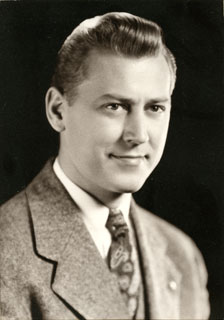
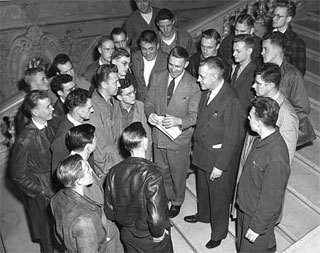


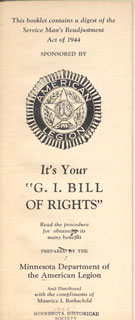
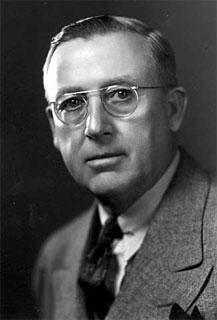
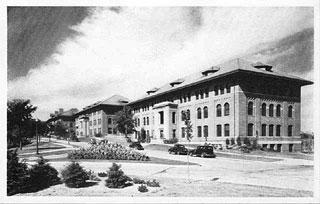
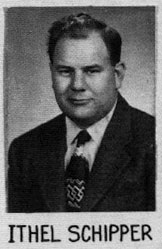
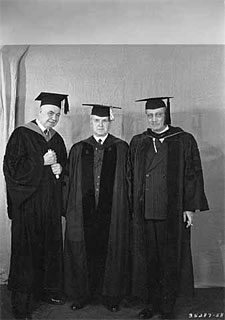
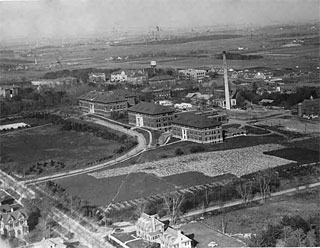
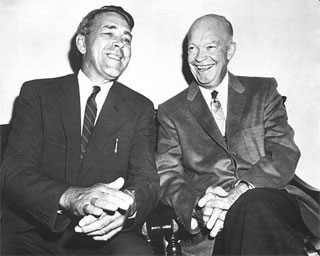


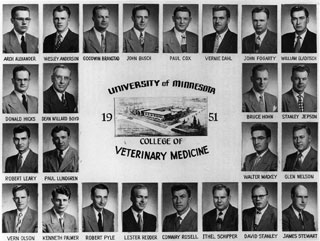

Source
Nelson, Glen H.; Linda Cameron, Interviewer, Glen H. Nelson Oral History Interview, 2007.


